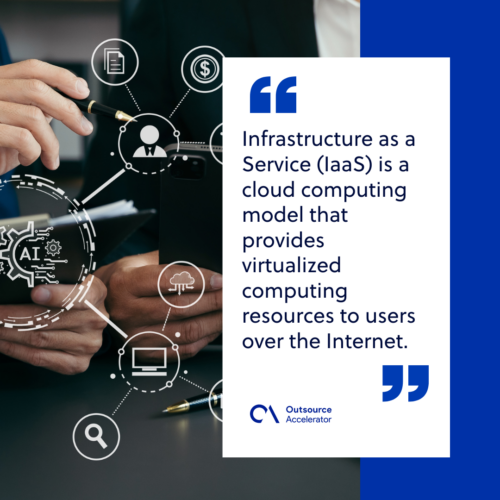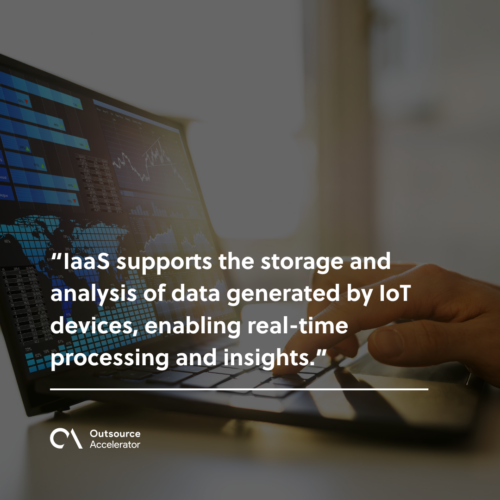Unlocking the potential of Infrastructure as a Service

Are you tired of constantly dealing with server maintenance, software updates, and storage issues? Imagine a world where you can say goodbye to all those headaches and instead focus on growing your business.
Enter Infrastructure as a Service (IaaS), a game-changer that has revolutionized how companies manage and deploy their IT infrastructure.
Envision having the power to access and scale computing resources on-demand, without the hefty upfront costs and complexity of maintaining physical hardware.
Let’s dive into the intricacies of IaaS, its benefits, and common use cases that can redefine how you approach IT infrastructure.
What is Infrastructure as a Service?
Infrastructure as a Service (IaaS) is a cloud computing model that provides virtualized computing resources to users over the Internet. It removes the need for businesses to manage physical hardware like servers, storage devices, and networking equipment.
Businesses instead rent essential IT infrastructure components from a third-party provider on a pay-as-you-go basis. They can leverage IaaS to access scalable and flexible resources, thereby reducing costs and complexity.

How does Infrastructure as a Service differ from other cloud services?
IaaS differs from other cloud services, such as Platform as a Service (PaaS) and Software as a Service (SaaS), in several key ways:
Level of control
IaaS provides the most control over the IT resources. Users manage operating systems, storage, and deployed applications, while the IaaS provider handles the physical infrastructure.
PaaS offers a higher-level environment for developing, testing, and deploying applications. Users focus on application code and settings, while the provider manages the infrastructure and platform, including operating systems and middleware.
SaaS delivers fully managed software applications over the Internet. Users access applications via a web browser, with the provider handling everything from infrastructure to application maintenance and updates.
Use cases
IaaS is ideal for businesses needing flexible and scalable resources, such as hosting websites, developing and testing applications, and running high-performance computing tasks.
PaaS is best suited for developers looking to build and deploy applications quickly without worrying about managing the underlying infrastructure.
SaaS targets end-users who need ready-to-use software solutions like email services, CRM systems, or collaboration tools.
Cost structure
IaaS is typically billed based on resource usage (e.g., compute hours, storage capacity). It allows for granular cost management and scaling according to demand.
PaaS usually charges based on application hosting time, number of users, or application transactions. It simplifies budgeting by abstracting infrastructure costs.
SaaS is often priced on a subscription basis per user or per feature set, making it straightforward to predict costs.
Management responsibilities
IaaS users are responsible for managing virtual machines, storage, and networking. This requires more technical expertise compared to PaaS and SaaS.
PaaS users manage application settings and code, while the provider takes care of runtime, databases, and servers.
For SaaS, the provider manages everything, and users only interact with the software interface and its features.
Understanding these distinctions helps businesses choose the right cloud service model based on their specific needs and resources.
How does Infrastructure as a Service work?
Infrastructure as a Service works by providing users with virtualized computing resources over the internet.
Here’s a breakdown of how IaaS functions:
Resource provisioning
The IaaS provider pools its physical resources and allocates them to multiple users based on demand. This ensures efficient utilization of hardware and allows for scalable, on-demand resource allocation.
Virtualization
The physical hardware resources are virtualized into virtual machines (VMs) or containers that run on physical servers.
Each VM can run its own operating system and applications. This provides the flexibility of a dedicated server without the need for physical hardware.
Self-service portal
Users can request and provision computing resources through a self-service portal or an Application Programming Interface (API). It allows them to configure and manage their virtual machines, storage, and networking settings according to their requirements.
Pay-per-use model
IaaS typically operates on a pay-as-you-go basis. Users are billed based on their actual usage of resources like compute hours, storage space, and data transfer.
This cost-effective model allows organizations to avoid upfront investments in physical infrastructure and pay only for the resources they consume.

Automated management
IaaS providers manage the physical hardware, networking, and data center facilities.
They also handle maintenance, updates, and security patches for the underlying infrastructure, allowing users to focus on managing their virtual resources and applications.
Advantages of Infrastructure as a Service
There are several benefits of using Infrastructure as a Service, including:
Cost efficiency
IaaS eliminates the need for large upfront investments in physical hardware and data centers. Instead, businesses pay for resources on a subscription or pay-as-you-go basis.
Maintenance, upgrades, and power costs are handled by the IaaS provider, reducing ongoing operational expenses.
Scalability and flexibility
With IaaS, businesses can easily scale their computing resources up or down, depending on demand.
In the case of unexpected increases in workload, IaaS supports rapid deployment of new applications and services. Companies can respond quickly to market changes and opportunities.
High availability and reliability
IaaS providers often offer robust service level agreements (SLAs) that ensure high uptime and reliability, with resources distributed across multiple data centers.
This also comes with a high level of redundancy, ensuring that the environment remains available and reliable.
Improved security measures
IaaS providers invest heavily in security technologies and practices, including firewalls, encryption, and access controls, to protect data and applications.
Providers often adhere to industry standards and regulations, helping businesses meet their own compliance requirements more easily.
Focus on business strategy
By providing a pre-built infrastructure that is maintained and managed by IaaS providers, organizations can focus on their core business operations. This enables them to prioritize innovation and growth.
Eliminates infrastructure maintenance:
IaaS reduces the burden of maintaining physical hardware. The provider assumes responsibility for infrastructure management, including hardware upgrades and routine maintenance.
Global reach
IaaS providers have data centers around the world. Businesses can deploy applications closer to their customers and improve performance through reduced latency.
Innovation and agility
IaaS allows businesses to quickly set up and test new ideas and applications without long procurement cycles, fostering a culture of innovation and agility.
Businesses can leverage the latest technologies and infrastructure advancements without significant investments, staying competitive in their industry.
Common use cases for Infrastructure as a Service
Infrastructure as a Service is versatile and supports a wide range of use cases.
Here are some common scenarios where IaaS is particularly beneficial:
Development and testing environments
IaaS is often used to create and manage temporary development and testing environments. Development teams can quickly set up and tear down environments for testing new software, speeding up the development lifecycle.
Web hosting and applications
Infrastructure as a Service provides a scalable and flexible platform for hosting websites and supporting infrastructure. It allows businesses to handle varying levels of web traffic.
Additionally, IaaS is commonly used for hosting and development of applications. Organizations are able to deploy and manage their software solutions without investing in physical infrastructure.
Disaster recovery and backup
IaaS offers secure and scalable storage solutions for backing up critical data, ensuring it can be restored if needed.
Businesses can implement disaster recovery plans using IaaS, replicating data across multiple locations to ensure business continuity in case of disruptions.
Big data and analytics
This service provides the computational power needed to process large datasets, enabling businesses to perform analytics and gain insights. As data volumes grow, IaaS allows for easy scaling of storage and processing capabilities.
High-performance computing
IaaS can be used to power HPC workloads. This includes scientific simulations, research computations, and engineering analysis, where the demand for computational power fluctuates.
E-commerce platforms
Infrastructure as a Service can provide a flexible and scalable infrastructure for hosting e-commerce platforms. It manages fluctuating traffic levels, ensuring a smooth shopping experience during peak times like holidays or sales.
Naturally, it also offers robust security measures and compliance certifications, protecting sensitive customer data.
Hybrid cloud deployments
IaaS can be used as part of a hybrid cloud strategy. Integrating public cloud resources with on-premises infrastructure can provide a seamless and unified environment.
Enterprise IT infrastructure
IaaS can replace or supplement traditional data centers. It can provide virtualized resources that mimic on-premises infrastructure.
Enterprises can manage workloads more efficiently, optimizing resource allocation and reducing operational costs.
IoT applications
IaaS supports the storage and analysis of data generated by IoT devices, enabling real-time processing and insights. As the number of connected devices grows, IaaS allows for scalable infrastructure to manage and process IoT data.

Content delivery
IaaS can be used to deploy content distribution networks (CDNs). These will improve the speed and reliability of content delivery to users globally.
Users will also be able to utilize media streaming. Businesses can host and stream media content efficiently, leveraging IaaS for high availability and performance.
Virtual desktops
IaaS can be used to create virtual desktop environments, allowing employees to access their workspaces from anywhere with an internet connection. This model is favorable to companies that support remote work.
Through virtual desktops, IT teams can manage and maintain desktop environments centrally, improving security and reducing management overhead.







 Independent
Independent




